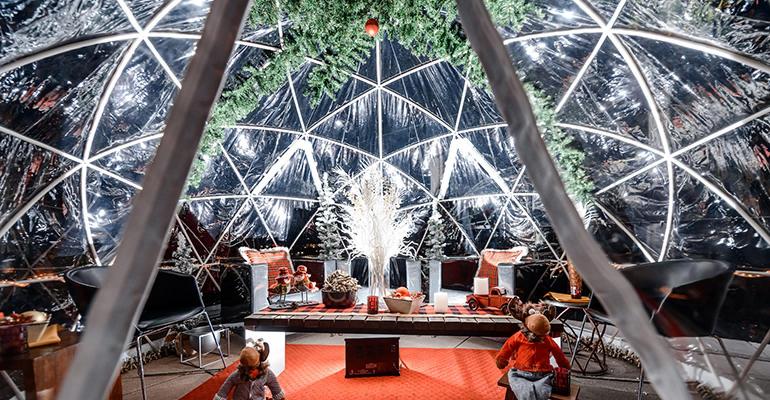As the question of how outdoor dining will work during the colder months becomes more urgent nationwide, the city of Chicago has released a list of rules and regulations for restaurants to follow during the fall and winter. The outdoor dining guidance allows for tents and other temporary structures, but they have to have 50% open sides with air flow, and igloos or dining bubbles for individual parties are also allowed, but they have to have proper ventilation. Additionally, all temporary outdoor dining structures larger than 400 feet and/or taller than 15 feet have to get a permit from the Department of Buildings.
According to the latest data from the Illinois State Medical Society, going to a bar with a mask on is a medium exposure risk for COVID-19, while eating indoors in a restaurant is a lower-medium exposure risk. The risk factor drops significantly to low-level risk for eating outdoors.
With this data in mind, it’s imperative that restaurants in Chicago and other geographic areas that experience cold winter months figure out quickly how to make their business work with these temporary structures.
The detailed list of requirements also includes:
- Temporary structures must be weighted into the ground but cannot cut or drill into the street or sidewalk
- Temporary structures may be deemed unsafe during severe weather events
- You must have a permit to install heating equipment outside
- Electric gas heaters are allowed but natural gas heaters can only be operated in open and uncovered areas, and all heaters must be an adequate distance from walls/tent flaps
- All plastic domes must provide written placards advising known risk
- A tent larger than 600 feet must obtain a standard building permit
- The same tent cannot be used for cooking as it is used for dining
- In the event of a winter storm, restaurants will need to provide a written plan and train staff to prevent injuries in unsafe weather condition.
While all of these guidelines might help restaurants figure out how to safely and legally comply with outdoor dining standards, many small restaurant operators won’t be able to afford large tents, yurts, and igloos.
With the city’s hospitality industry on the line, Chicago began asking for creative submissions for solutions to the outdoor dining dilemma on Open Ideo at the end of August. The Winter Design Challenge, which ran through Sept. 7, received 415 submissions and although winners have not been announced yet, the ideas — ranging from luxury yurts and tents to more creative and affordable solutions — include converting old Chicago busses and trains that are no longer in use, dining inside modular greenhouses, covered Kotasu Japanese tables, rotating restaurants in Chicago’s parks, and dining tents with sliding walls.
Winners of the contest will each receive $5,000 and the city is currently looking for corporate sponsors to fund putting these ideas into action.
But as the city approaches its colder months, restaurants could have a tough time even getting set up to try tent/yurt/igloo/greenhouse dining, as patio heaters are selling out quickly, and those that remain have been price gouged, according to Eater.
Anna Posey, chef and co-owner of Michelin-starred Chicago restaurant Elske told Eater that she had placed orders for heaters from Lowe’s for $140 each, and then received an email asking them to wait for confirmation. Eventually they were allegedly told that “the manufacturer can’t agree on a price, so they’re cancelling any orders that are currently pending.” Operators are likening the shopping experience to how people were panic-buying toilet paper in the early days of the pandemic.
Contact Joanna Fantozzi at [email protected]
Follow her on Twitter: @joannafantozzi





